Bittermelons, also called karela
Cut in half, then remove the seeds
bittermelons waiting to be stir-fried
Karela with garlic, ginger, onions, and mustard seeds.
Served with some black chickpeas and couscous, and potatoes
When was the last time you tried a totally new food? I recently retried eating bittermelon, or in Gujarati, karela (kha-reh-la). Bittermelons are a type of really bitter squash with a spicy, slightly pungent taste, that works to clear the palette. I think bittermelons taste very good with lentils and dhal.
Up for a bitter treat?
Growing up, bitter flavors were loved by my parents (fenugreek leaves called methi, bittermelon, unripe mangoes, pani-puri pani, vhal – a type of broad bean similar to limas, and even cilantro). Bittermelon is not exactly kid-friendly food. As kids, we'd explain how awful the bitter taste was, and how nothing could mask (we'd dip our veggies in ketchup, Cool Whip, drown it in yogurt, dhal, whatever) that awful mouth puckering bitter flavor. My parents, having a strict no food-waste policy, would force us to finish our plates. Begrudgingly, we'd finish the food, complaining all the while, and taking dollops of Cool Whip out (somehow this was allowed). All those years of forcing us to clean our plates did not create a terrible relationship with the foods we grew up eating, my siblings and I love food (sweet, sour, bitter and salty!) Now we force those foods on our friends and families.
Today, bitter foods do not bother me. I love methi theplas (a type of tortilla made with fenugreek leaves – and btw, mom, if you're reading this I need that recipe), and I have tried lambic guezes and other wild ales which are both sour and bitter. So why not try bittermelon again? Most Asian or South Asian stores carry them. Look for warty green spiky cucumber-like squash with no obvious bruising or wilting. Asians and South Asians LOVE bittermelon. This is a simple way to prepare them, and is my mom's way of prepping them. I served this with some black chickpeas, potatoes, and couscous.
Indians believe that bittermelon, and many bitter fruits and vegetables, helps to reduce or improve the symptoms of type 2 diabetes - and that their consumption can also work to prevent type 2 diabetes. They also believe that bitter foods help thin the blood, which results in less cardiovascular diseases.
Gujarati-style Bittermelon
(Karela ni shak)
Serves: 4
Ingredients:
2 small-medium bittermelons (4-6” long)
1 tsp olive oil
1 clove garlic, chopped
1 tsp, ginger, chopped fine
½ tsp mustard seeds
pinch of asafoetida or hing
½ cup onion, diced
½ cup water
1-2 tomatoes, diced (helps to cut down on bitterness)
salt to taste
½ tsp turmeric
½ tsp cumin
cilantro to garnish
Directions:
- Wash and cut the bittermelons in half. Cut the halves lengthwise and remove the seeds. You can also cut it into 1/2” segments and remove the seeds and white pith.
- Make a vaghar. A vaghar is when you heat up oil and add seeds and some spices to release their flavors. Vaghars are the lifeline of Guju cooking. Heat up the olive oil over medium heat. Add in mustard seeds and hing. When the mustard seeds begin to pop, add in ginger, garlic, and onions. Stir and cook.
- Add in bittermelon and stir fry for about 10 minutes. Add in water and add in salt, turmeric, and tomatoes. Continue cooking another 10 minutes.
- Add in cumin powder, stir to combine and garnish with cilantro. Serve.

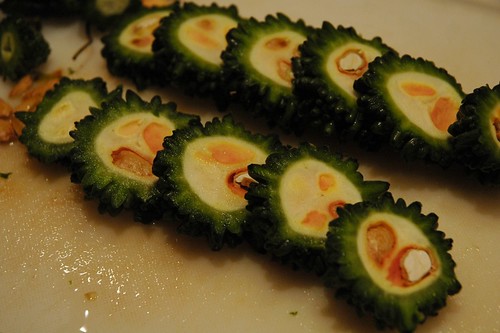
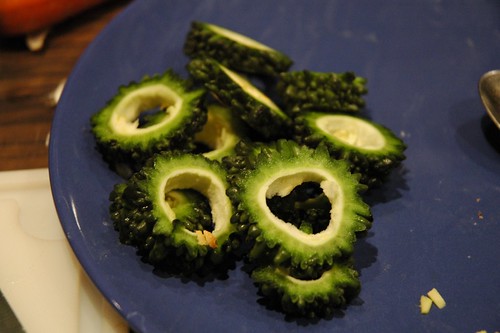
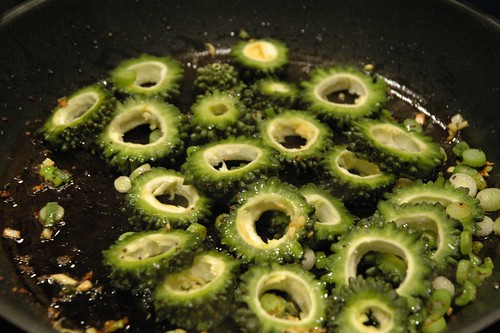
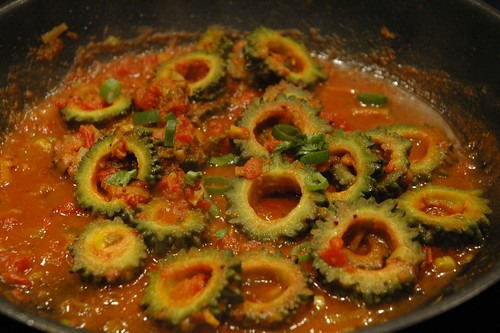
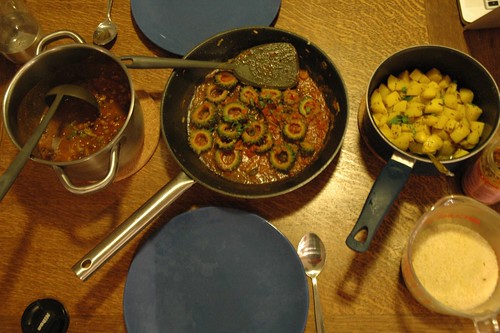

Fabulous. Absolutely fabulous. I am stunned by the perseverance at which you challenge yourself in cooking new (or long-lost) foods... I need to come back and look at this recipe more closely when I have more time, but for now: proficiat! :)
ReplyDeleteWhere did you find these crazy spikey buggers? I'd be interested to try them, although I have to say, the rind looks crazy tough.
ReplyDeleteI am also jealous of your incredible culinary skills. The most I can seem to do is a simple stir-fry with the usual zucchini and peppers.
I know, they look like mutant dinosaur squash! Thanks for such kind comments. I found them in a Pakistani market near Brussel Zuid. I couldn't help but buy them. It reminded me of "home," and the rind looks tough, but cooks up to be soft, I'll let you guess the overall flavor of these =) Don't be jealous of my cooking skills - I usually plan meals and try to include foods I really miss (or don't feel like paying for..e.g. Mexican food) You can too!
ReplyDeleteNeeli, I can't believe you were crazy enough to actually eat karela in shak form. I can only eat them when they're in dahl, or liquified in some other dish that masks the bitterness.
ReplyDeleteI used to drink a little of fresh karela juice everyday when I made it for Papa. It's good for controlling blood sugar. I used to pinch my nose and gulp down the whole two tablespoons.
Jai
You don't think our nonsense about eating it came from our exposure to only salty and sweet foods as kids? I like bitter things now - I mean these bitter bombs, but still they weren't even half as bad as I remember them. My mom used to make juice shots as well. Neil and I would dare each other to gulp them down. I never thought they were so bad (I think the eating of Cool Whip was loads worse). I can't remember if you had seen that when you'd visit, but I'm sure your mom and sister remember!
ReplyDeleteIntrigued and intimidated!
ReplyDelete